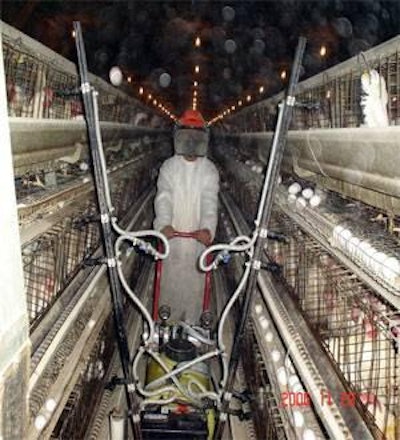
Vaccinations for a variety of diseases that used to plague the layer industry now allow for large numbers of layers to be housed on multi-age sites with minimal mortality and a high rate of lay. Dr. Andy McRee, technical services veterinarian, Lohmann Animal Health International, speaking at the Midwest Poultry Federation Convention’s Egg Production Workshop, said that the vaccine used is only part of the equation needed to ensure protection for a flock. “A vaccine is only as good as the manner in which it is administered,” he said. Because of this, McRee said that it is important to audit your vaccination crews to make certain that the vaccines are being properly administered and your birds are being protected.
Your vaccination program
McRee said that preventing disease is much less costly than treating the bird, but that doesn’t mean that flocks need to be vaccinated for all diseases. He said that the decision of whether or not to vaccinate a flock to prevent a particular disease needs to take into account all of the costs and benefits of vaccination. You need to look at all of the labor and material costs involved in administering the vaccination. Ideally, you want to induce protection without compromising performance, but performance can be negatively affected by the stress of vaccination.
Layers are vaccinated to prevent clinical disease, to protect shell quality and to prime them for future vaccines. Some breeder vaccinations are used as a means of providing protection for their progeny.
There is no universal vaccination program that is right for all layers, but McRee said that effective vaccination plans share certain characteristics. An effective vaccination program will have established goals with a purpose and a plan. The vaccine antigens used will be matched with the field challenges in your area. Vaccinations will be timed to meet the expected field challenges. Vaccines will be properly stored and handled prior to administration, and they will be properly administered. The entire process will be monitored and audited and will be adjusted as needed.
McRee said that vaccination crews have a tough job to do, and that they should be rewarded for a job well done. Some key areas of concern with vaccination administration are not associated with effort or care exhibited by the crews, but rather from a lack of understanding of some basic biology. He said that many vaccination crews reconstitute vaccine well in advance of use. This can reduce the effectiveness of the vaccine and he stressed that crews should only reconstitute the vaccine as needed. Some crews use an open vaccine reservoir to hold vaccine for the wing web stick method of vaccination. Given the dust stirred up in the air of the house during vaccination, it doesn’t take long for this open reservoir to become contaminated with bacteria. This can lead to infection in the wing and interfere with the immune response needed for proper vaccination. Finally, McRee said that he does see instances where vaccination crews try to carry too many birds in one hand or fail to release birds in a suitable manner.
Vaccination methods
Vaccinations for laying hens are primarily administered in one of five ways: in the drinking water, as a coarse spray on the body, with drops in the eye, as a wing web stick, or as an injection, either subcutaneous or intramuscular. McRee said that wing web vaccinations can be somewhat problematic depending on how they are administered.
Most wing web vaccines are just applied with a prick in the skin and they are not injected, according to McRee. The needle is just dipped into the vaccine solution and then stuck in the wing web. He said that if the vaccine reservoir is open to the air, then it won’t take long for the reservoir to be contaminated, which can ultimately lead to infection at the vaccination site in the bird.
McRee also stated that birds can wind up with a staphylococcus infection from the vaccination. Staphylococcus infections can lead to leg infections and foot problems. He wondered whether or not staphylococcus infections causing bumble foot in broiler breeders could be coming from wing web vaccinations.
Sprayers, like a Christmas tree or Steinberger sprayer, can be effectively used to administer coarse spray vaccines to hens in cages, McRee reported. He recommended the use of vaccine stabilizers that also have dye in them so you can see that the birds have gotten the vaccine. The dye is useful for all of the methods of vaccine administration.
McRee said that decisions regarding your vaccination program need to weigh all of the costs and benefits of vaccination. He said that it is possible that labor and material costs to vaccinate a flock may outweigh the benefits of protection given by a particular vaccination. Ideally, you want to induce protection in the flock without compromising flock performance.





![Don Adams, vice president, sustainability, Keystone Foods, said “In the future, it may be necessary to have a good [corporate social responsibility] program to have a seat at the table.”](https://img.wattagnet.com/files/base/wattglobalmedia/all/image/2015/04/an.1204EIsustainAdams.jpg?auto=format%2Ccompress&fit=crop&h=167&q=70&w=250)












